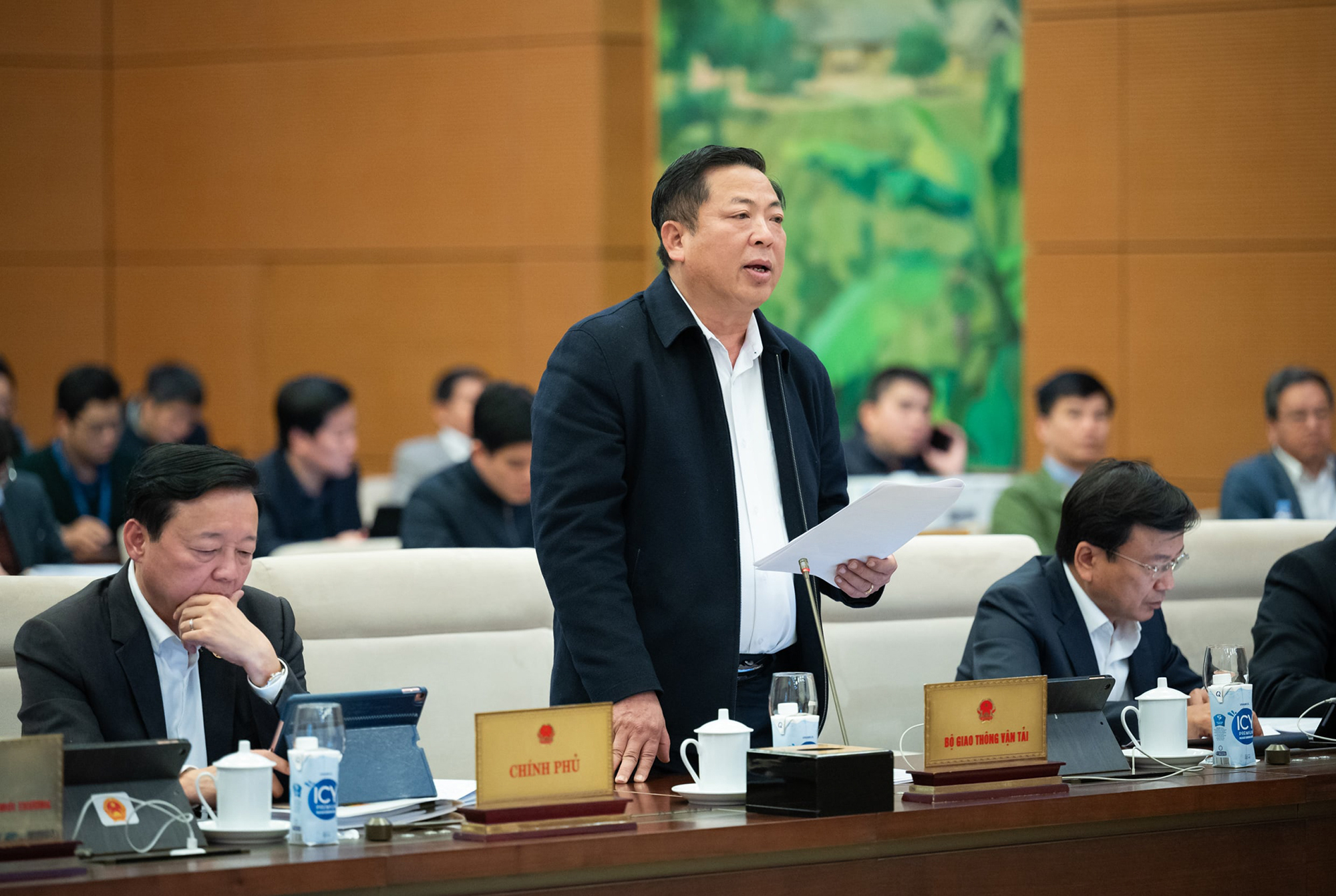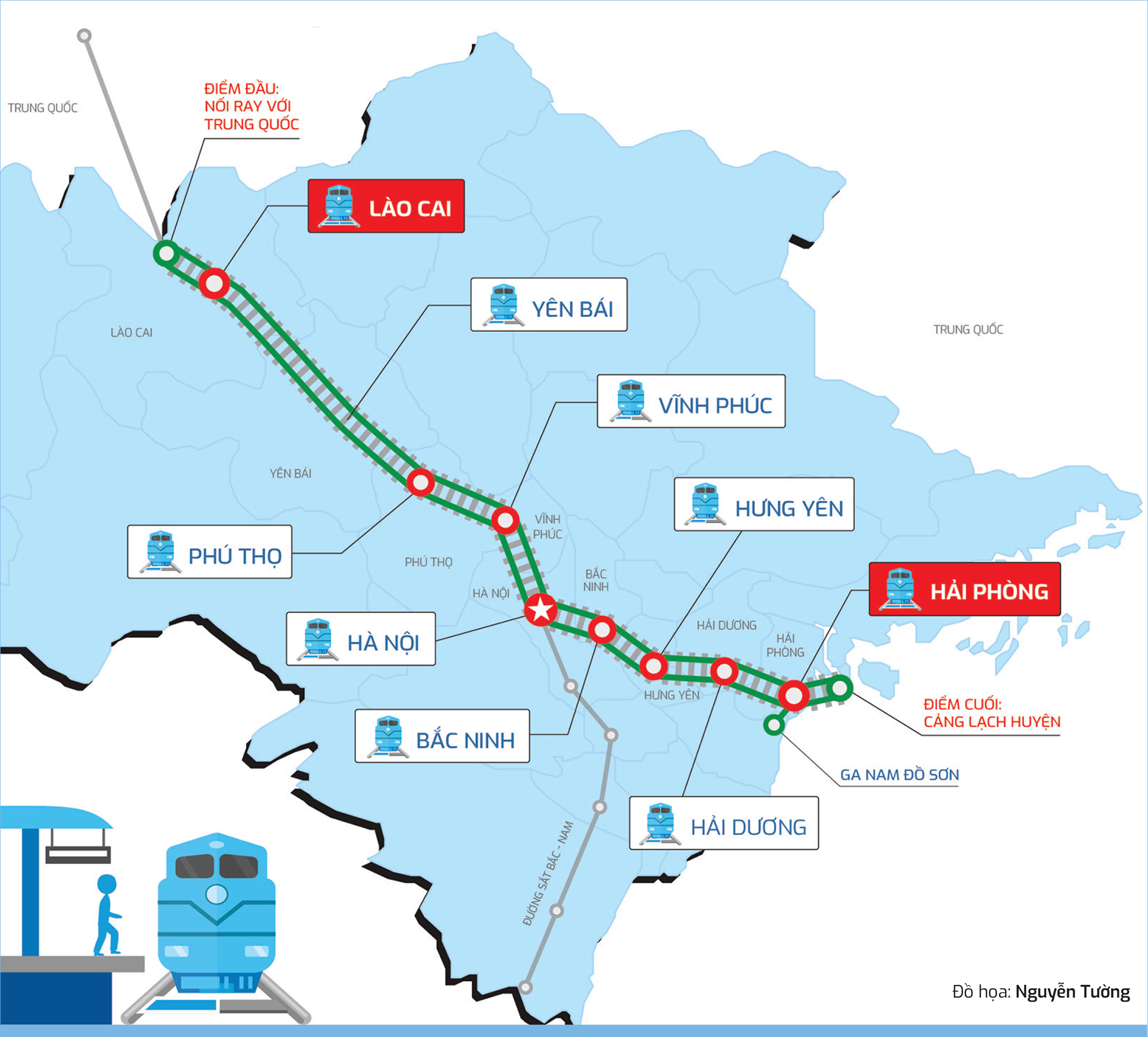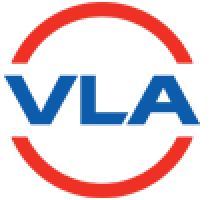High Expectations for the 8.3 Billion USD Railway Project Connecting Lao Cai – Hanoi – Hai Phong
vlimonamedia
11/02/2025
The proposed railway route, once invested in, will open up significant opportunities for transportation, international connectivity, and logistics cost reduction. To implement this, several specific mechanisms have been proposed.
On February 10, the Standing Committee of the National Assembly discussed the investment policy for the Lao Cai – Hanoi – Hai Phong railway line with a gauge of 1,435mm.
The Shortest, Straightest Route Possible
Presenting the proposal from the Government, Minister of Transport Tran Hong Minh stated that the project will have its starting point at the new Lao Cai station connecting the rail to the border with China at the Ha Khau North station (China), located in Lao Cai City. The endpoint will be at the Lach Huyen terminal in Hai Phong City. The main route is approximately 390.9 km long, with three branch lines totaling around 27.9 km.

The project passes through 9 provinces and cities: Lao Cai, Yen Bai, Phu Tho, Vinh Phuc, Hanoi, Bac Ninh, Hung Yen, Hai Duong, and Hai Phong. The preliminary total investment is about 203,231 billion VND (approximately 8.369 billion USD).
The Government recommends financing sources for the project, including the state budget (central and local), domestic funds, foreign capital (loans from the Chinese government), and other legal funding sources.
Regarding the investment scale, the project will build a new electrified 1,435mm gauge railway for both passenger and freight transport. The main line from Lao Cai to Nam Hai Phong station is designed with a speed of 160 km/h, while the section through Hanoi’s junction area is designed for a speed of 120 km/h, and the connecting and branch lines are designed for 80 km/h.
For technology, the project will use concentrated power train technology for both passenger and freight trains, with an information and signaling system equivalent to that used on certain regional rail lines for combined passenger and freight transport.
According to Minister Tran Hong Minh, the route has been researched and chosen to ensure it is as short and straight as possible, aligning with approved planning regulations.
Regarding station construction, 18 stations are planned (including 3 for train formation and 15 mixed stations). As demand increases during operations, some technical stations will be upgraded to mixed stations, and additional stations will be invested in when necessary.
For the project timeline, the Government proposes to complete the feasibility study report by 2025, with a target to complete the project by 2030.
Solving the “Bottleneck” in Intermodal Transport
According to reporters’ observations in early February, sulfur shipments by rail from the Hai Phong area to China via Lao Cai are still regularly carried out.

Mr. Duong Van Hung, Chairman and CEO of Hai Phong Railway Transport Services Joint Stock Company (the company renting the railway for transport), stated that this is a traditional item the company handles for its Chinese partners. In addition to sulfur, ores and other bulk goods are transported with an annual two-way volume of around 350,000 tons.
Previously, sulfur, iron ore, and other cargo passed through Hai Phong Port and were transported by train via Lao Cai to Chinese factories. However, about 10 years ago, when China constructed a 1,435mm gauge railway to the Ha Khau North station near the border, volumes declined because Vietnam’s railway still used a 1,000mm gauge.
Very few 1,000mm gauge locomotives and carriages were compatible with Chinese railways, so most trains had to stop at Lao Cai station to transfer goods to Chinese wagons. At Ha Khau North, to go deeper into China, goods had to be transferred again to 1,435mm gauge wagons, causing delays and increasing costs.
In response to the news about the Lao Cai – Hanoi – Hai Phong railway being presented for investment approval by the National Assembly, Mr. Nguyen Hoang Thanh, Deputy General Director of the Railway Transport and Trade Joint Stock Company (Ratraco), stated that this would help businesses save time and reduce costs related to import and export.
Creating a Market Worth Over 4.5 Billion USD
According to Mr. Vu Hong Phuong, Director of the Railway Project Management Unit, the East-West corridor (Hai Phong – Hanoi – Lao Cai) passes through 9 localities accounting for 21% of GDP and 25% of industrial zones nationwide. This is the second most important transport corridor after the North-South corridor.
Investing in this railway will create a construction market valued at over 4.5 billion USD, approximately 90,000 jobs during construction, and around 2,500 long-term jobs.
Additionally, the route will connect with Chinese railways, linking through rail lines to Yunnan, Tibet, and eventually to Europe. Vietnam’s export goods will be transported by rail via Lao Cai border gate along this new route.
According to Mr. Nguyen Ngoc Dong, former Deputy Minister of Transport, of the 7 proposed rail lines, the North-South line is characterized by high passenger demand, while the East-West line addresses urgent needs for freight transport and connectivity. Vietnamese goods transported to Europe by rail would see a cost reduction of 1/3 to nearly 1/2 compared to shipping by sea, and the transit time would also be shortened by 14-20 days.
Proposal for Specific Mechanisms
To begin the project by the end of 2025, as directed by the Government, Mr. Vu Hong Phuong stated that the Ministry of Transport is carrying out several tasks simultaneously.
Specifically, while preparing the pre-feasibility study report, the Ministry of Transport is also working on the feasibility study, negotiating loan agreements, and other tasks.
The Ministry of Transport has proposed a series of special policies, including a group of policies aimed at accelerating progress, such as approval authority, project adjustment authority, funding sources, and allowing direct contracting for all steps that could affect the project’s start time.
Specifically, the Ministry has proposed 19 policy groups for approval by the National Assembly. Among them, 15 out of 19 policies are proposed to be applied as per Resolution No. 172/2024/QH15 of the National Assembly on the investment policy for the North-South high-speed railway project.
Moreover, the Ministry has proposed adding 4 new policy groups under the National Assembly’s authority, including allowing the project investor to directly contract major project packages as per Article 23 of the Bidding Law.
Lessons learned from previous projects indicate that two major factors often delay construction progress: land acquisition, compensation, and resettlement (LAC, compensation, and resettlement) at the local level, as well as disputes between investors and contractors over economic contracts.
To address these issues, the Ministry has proposed specific mechanisms for land acquisition, compensation, and resettlement, such as using preliminary design documents (after National Assembly approval) to prepare localities for land acquisition and resettlement activities before the investment policy is approved.
Thorough Evaluation to Avoid Risks
Presenting the report on the appraisal of the Government’s proposal, Vu Hong Thanh, Chairman of the Economic Committee of the National Assembly, stated that the Economic Committee agrees on the necessity of investing in the project based on political, legal, and practical grounds presented by the Government.
Regarding the route, the appraisal agency recommends that during the feasibility study phase, the Government instructs relevant agencies to carefully review and select the optimal route option, ensuring proper integration with the national railway network, urban rail systems, and other transportation networks.
The Economic Committee also urges a comprehensive assessment of the effectiveness of other proposed rail projects and a detailed evaluation of financial plans and potential impacts during operations to minimize risks later on.
To ensure feasibility and effectiveness, it is essential for the Government to propose that the National Assembly approve some of the special mechanisms and policies, which are deemed necessary.
Theo: Báo Giao thông
Tag




